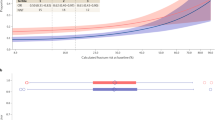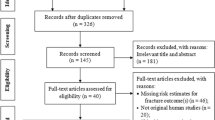Abstract
Fractures are a clinical consequence of osteoporosis, and represent a major cause of morbidity and mortality worldwide. Several treatments have been shown to decrease the risk of fracture, but problems arise in identifying individuals at high fracture risk so that treatments can be effectively targeted. The case for widespread population screening using bone mineral density testing is weak, as these tests lack sensitivity. Case-finding algorithms are available in many countries, but differ markedly in their approaches. Recent developments in fracture risk assessment include the availability of the FRAX® (WHO Collaborating Center for Bone Metabolic Disease, Sheffield, UK) tool, which integrates the weight of clinical risk factors for fracture risk with or without information on bone mineral density, and computes the 10-year probability of fracture. The tool increases sensitivity without trading specificity, and is now being used in the reappraisal of clinical guidelines.
Key Points
-
Despite a substantial burden of disease and the availability of treatments for osteoporosis, problems remain in identifying patients in whom treatment should be considered
-
Global strategies to improve bone mineral density (BMD) in the general population are untested
-
Screening and case-finding strategies using BMD testing are specific (they identify high-risk patients) but lack sensitivity (they miss many who will experience fractures)
-
Case finding can be enhanced by the consideration of clinical risk factors that provide information on fracture risk over and above that provided by BMD measurements
-
The FRAX® tool integrates information on fracture risk from clinical risk factors with or without BMD, and can be used to improve the targeting of treatment to individuals at high fracture risk
This is a preview of subscription content, access via your institution
Access options
Subscribe to this journal
Receive 12 print issues and online access
$209.00 per year
only $17.42 per issue
Buy this article
- Purchase on Springer Link
- Instant access to full article PDF
Prices may be subject to local taxes which are calculated during checkout




Similar content being viewed by others
References
Kanis, J. A., on behalf of the World Health Organization Scientific Group. Assessment of osteoporosis at the primary health-care level. Technical Report, Sheffield, UK. WHO Collaborating Centre, University of Sheffield, UK (2008).
Kanis, J. A. et al. Long-term risk of osteoporotic fractures in Malmö. Osteoporos. Int. 11, 669–674 (2000).
Melton, L. J. 3rd. Adverse outcomes of osteoporotic fractures in the general population. J. Bone Miner. Res. 18, 1139–1141 (2003).
Burge, R. et al. Incidence and economic burden of osteoporosis-related fractures in the United States, 2005–2025. J. Bone Miner. Res. 22, 465–475 (2007).
Kanis, J. A. et al. A reference standard for the description of osteoporosis. Bone 42, 467–475 (2008).
World Health Organization. Assessment of fracture risk and its application to screening for postmenopausal osteoporosis. Technical Report Series, No. 843 (WHO, Geneva, 1994).
Riggs, B. L. & Melton, L. J. The prevention and treatment of osteoporosis. N. Engl. J. Med. 327, 620–627 (1992).
Kanis, J. A. Use of calcium in the management of osteoporosis. Bone 24, 279–290 (1999).
Johnell, O., Stenbeck, M., Rosen, M., Gullberg, B. & Kanis, J. A. Therapeutic strategies in the prevention of hip fracture with drugs affecting bone metabolism. Bone 14 (Suppl. 1), 85–87 (1993).
Marshall, D. A., Sheldon, T. A. & Jonsson, E. Recommendations for the application of bone density measurement. Int. J. Technol. Assess. Health Care 13, 411–419 (1997).
Pitt, F. A. et al. The Costs and Benefits of Screening for and Preventing Osteoporosis in Trent Region: A Report of the Trent Regional Osteoporosis Working Party (Trent Health, Sheffield, UK, 1990).
[No authors listed] Bone density measurement—a systematic review. A report from SBU, the Swedish Council on Technology Assessment in Health Care. J. Intern. Med. Suppl. 739, 1–60 (1997).
Cummings, S. R. & Black, D. Should perimenopausal women be screened for osteoporosis? Ann. Intern. Med. 104, 817–823 (1986).
Ott, S. Should women get screening bone mass measurements? Ann. Intern. Med. 104, 874–876 (1986).
Melton, L. J. 3rd, Eddy, D. M. & Johnston, C. C. Jr. Screening for osteoporosis. Ann. Intern. Med. 112, 516–528 (1990).
Kanis, J. A. Screening for Postmenopausal Osteoporosis. A review for the Department of Health, London, UK. (1992).
European Commission. Report on Osteoporosis in the European Community—Action for Prevention (Office for Official Publications of the European Communities, Luxembourg, 1998).
Kanis, J. A. et al. Ten-year risk of osteoporotic fracture and the effects of risk factors on screening strategies. Bone 30, 251–258 (2002).
National Osteoporosis Foundation (NOF). Physician's Guide to Prevention and Treatment of Osteoporosis (National Osteoporosis Foundation, Washington, DC, 2003).
US Preventive Services Task Force. Screening for Osteoporosis in Postmenopausal Women (Office of Disease Prevention and Health Promotion, Washington, DC, 2003).
US Preventive Services Task Force. Screening for osteoporosis in postmenopausal women: recommendations and rationale. Ann. Intern. Med. 137, 526–528 (2002).
Lewiecki, E. M. et al. Official positions of the International Society for Clinical Densitometry. J. Clin. Endocrinol. Metab. 89, 3651–3655 (2004).
Cheung, A. M., Feig, D. S., Kapral, M., Diaz-Granados, N. & Dodin, S. Prevention of osteoporosis and osteoporotic fractures in postmenopausal women: recommendation statement from The Canadian Task Force on Preventive Health Care. CMAJ 170, 1165–1167 (2004).
Dutch Institute for Healthcare Improvement. Osteoporose: Tweede Herziene Richtlijn [online]. (2002). English summary: Pols, H. A. & Wittenberg, J. CBO guideline “Osteoporosis” (second version). NTVG Ned Tijdschr Geneeskd 146, 1359–1363 (2002).
Royal College of Physicians. Osteoporosis: Clinical Guidelines for the Prevention and Treatment (Royal College of Physicians, London, 1999).
Royal College of Physicians and Bone and Tooth Society of Great Britain. Update on Pharmacological Interventions and an Algorithm for Management (Royal College of Physicians, London, 2000).
Kanis, J. A., Delmas, P., Burckhardt, P., Cooper, C. & Torgerson, D. Guidelines for diagnosis and management of osteoporosis. Osteoporos. Int. 7, 390–406 (1997).
Kanis, J. A. Diagnosis of osteoporosis and assessment of fracture risk. Lancet 359, 1929–1936 (2002).
Bone and Tooth Society of Great Britain, National Osteoporosis Society and Royal College of Physicians. Glucocorticoid-Induced Osteoporosis: Guidelines on Prevention and Treatment (Royal College of Physicians, London, 2002).
Kanis, J. A. et al. European guidance for the diagnosis and management of osteoporosis in postmenopausal women. Osteoporos. Int. 19, 399–428 (2008).
Kanis, J. A. et al. A new approach to the development of assessment guidelines for osteoporosis. Osteoporos. Int. 13, 527–536 (2002).
World Health Organization. Assessment of Osteoporosis at the Primary Health Care Level. Summary Report of a WHO Scientific Group [online] (2007).
FRAX® WHO Fracture Risk Assessment Tool [online] (2009).
Kanis, J. A. et al. The use of clinical risk factors enhances the performance of BMD in the prediction of hip and osteoporotic fractures in men and women. Osteoporos. Int. 18, 1033–1046 (2007).
Kanis, J. A. et al. Case finding for the management of osteoporosis with FRAX®—assessment and intervention thresholds for the UK. Osteoporos. Int. 19, 1395–1408 (2008).
Siminoski, K. et al. Recommendations for bone mineral density reporting in Canada: a shift to absolute fracture risk assessment. J. Clin. Densitom. 10, 120–123 (2007).
Fujiwara, S. et al. Development and application of a Japanese model of the WHO fracture risk assessment tool (FRAX™). Osteoporos. Int. 19, 429–448 (2008).
Kurth, A. A. & Pfeilschifter, J. Diagnosis and treatment of postmenopausal osteoporosis and osteoporosis in men. German Guidelines Update 2006 [German]. Orthopade. 36, 683–690 (2007).
Dawson-Hughes, B. et al. Implications of absolute fracture risk assessment for osteoporosis practice guidelines in the USA. Osteoporos. Int. 19, 449–458 (2008).
Siris, E. & Delmas, P. D. Assessment of 10-year absolute risk: a new paradigm with worldwide application. Osteoporos. Int. 19, 383–384 (2008).
Kanis, J. A. et al. The cost-effectiveness of alendronate in the management of osteoporosis. Bone 42, 4–15 (2008).
Kanis, J. A., Stevenson, M., McCloskey, E. V., Davis, S. & Lloyd-Jones, M. Glucocorticoid-induced osteoporosis: a systematic review and cost-utility analysis. Health Technol. Assess. 11, 1–256 (2007).
Kanis, J. A. & Johnell, O. Requirements for DXA for the management of osteoporosis in Europe. Osteoporos. Int. 16, 229–238 (2005).
National Osteoporosis Guideline Group on behalf of the Bone Research Society, British Geriatrics Society, British Society of Rheumatology, Society of Endocrinology, British Orthopaedic Association, Primary Care Rheumatology Society, Osteoporosis 2000 and Osteoporosis Dorset. Osteoporosis: Clinical Guideline for Prevention and Treatment (University of Sheffield, Sheffield, UK, 2008).
National Osteoporosis Guideline Group. Guidance for the Identification of Individuals at High Fracture Risk [online] (2009).
Czerwinski, E., Badurski, J. E., Marcinowska-Suchowierska, E. & Osieleniec, J. Current understanding of osteoporosis according to the position of the World Health Organization (WHO) and International Osteoporosis Foundation. Ortop. Traumatol. Rehabil. 9, 337–356 (2007).
Tsang, S. W. Y., Kung, A. W. C, Kanis, J. A., Johansson, H. & Oden, A. Ten-year fracture probability in Hong Kong southern Chinese according to age and BMD femoral neck T-scores. Osteoporos. Int. doi:10.1007/s00198-009-0906-1
Lippuner, K., Johansson, H., Kanis, J. A. & Rizzoli, R. Remaining lifetime and absolute 10-year probabilities of osteoporotic fracture in Swiss men and women. Osteoporos. Int. doi:10.1007/s00198-008-0779-8
Tosteson, A. N. et al. National Osteoporosis Foundation Guide Committee. Cost-effective osteoporosis treatment thresholds: the United States perspective. Osteoporos. Int. 19, 437–447 (2008).
Kanis, J. A., Brazier, J. E., Stevenson, M., Calvert, N. W. & Lloyd Jones, M. Treatment of established osteoporosis: a systematic review and cost-utility analysis. Health Technol. Assess. 6, 1–146 (2002).
Kanis, J. A. et al. Intervention thresholds for osteoporosis in the UK. Bone 36, 22–32 (2005).
Kanis, J. A. et al. Intervention thresholds for osteoporosis in men and women: a study based on data from Sweden. Osteoporos. Int. 16, 6–14 (2005).
Borgström, F., Johnell, O., Kanis, J. A., Jönsson, B. & Rehnberg, C. At what hip fracture risk is it cost-effective to treat? International intervention thresholds for the treatment of osteoporosis. Osteoporos. Int. 17, 1459–1471 (2006).
Acknowledgements
Charles P. Vega, University of California, Irvine, CA is the author of and is solely responsible for the content of the learning objectives, questions and answers of the MedscapeCME-accredited continuing medical education activity associated with this article.
Author information
Authors and Affiliations
Corresponding author
Ethics declarations
Competing interests
The authors declare no competing financial interests.
Rights and permissions
About this article
Cite this article
Kanis, J., McCloskey, E., Johansson, H. et al. Approaches to the targeting of treatment for osteoporosis. Nat Rev Rheumatol 5, 425–431 (2009). https://doi.org/10.1038/nrrheum.2009.139
Issue Date:
DOI: https://doi.org/10.1038/nrrheum.2009.139
This article is cited by
-
Long non-coding RNA H19 regulates matrisome signature and impacts cell behavior on MSC-engineered extracellular matrices
Stem Cell Research & Therapy (2023)
-
Long noncoding RNAs: a missing link in osteoporosis
Bone Research (2019)
-
Aloin promotes osteogenesis of bone-marrow-derived mesenchymal stem cells via the ERK1/2-dependent Runx2 signaling pathway
Journal of Natural Medicines (2019)
-
How to decide intervention thresholds based on FRAX in central south Chinese postmenopausal women
Endocrine (2014)
-
Taurine promotes human mesenchymal stem cells to differentiate into osteoblast through the ERK pathway
Amino Acids (2014)



